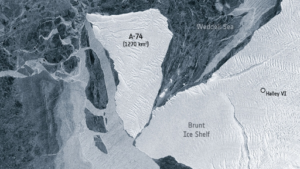In news– An iceberg, nearly the size of Delhi, has been floating in Antarctica’s Weddell Sea, threatening to collide with the Brunt Ice Shelf that it first broke from earlier this year.
Key updates-
- The Brunt Ice Shelf attached to the western tip of Antarctica was saved from a devastating collision with a 1,270-square kilometre iceberg.
- According to the European Space Agency (ESA), a chunk bigger than the iceberg A-74 would have been knocked off the ice shelf had the impact been stronger.
- Though the iceberg broke off Brunt late February this year, Strong ocean currents prevented it from floating westward into the Wendell Sea and it hovered close to the shelf’s west coast for six months.
- Strong easterly winds redirected the giant mass of ice in early August.
- It began to travel southwards, brushing lightly against the western tip of Brunt, as captured by the agency’s Copernicus Sentinel-1 satellite.

About Brunt Ice Shelf-
- The Brunt Ice Shelf borders the Antarctic coast of Coats Land between Dawson-Lambton Glacier and Stancomb-Wills Glacier Tongue.
- It was named by the UK Antarctic Place-names Committee after David Brunt, British meteorologist, Physical Secretary of the Royal Society, 1948–57, who was responsible for the initiation of the Royal Society Expedition to this ice shelf in 1955.
- It was the location of the base of the Royal Society Expedition, 1955–59 which was taken over as the British Halley Research Station/British Antarctic Society’s Halley VI observatory..
Copernicus Sentinel-1 satellite-
- The Sentinel-1 mission comprises a constellation of two polar-orbiting satellites, operating day and night performing C-band synthetic aperture radar imaging, enabling them to acquire imagery regardless of the weather.
- Sentinel-1 will work in a pre-programmed operation mode to avoid conflicts and to produce a consistent long-term data archive built for applications based on long time series.
- Sentinel-1 is the first of the five missions that ESA is developing for the Copernicus initiative.














